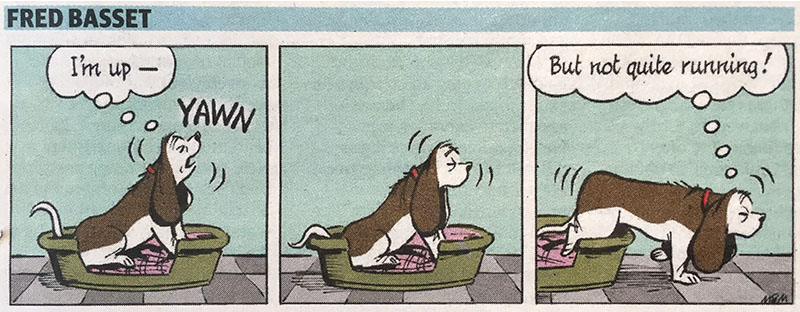My work gets daily newspaper deliveries, and at afternoon tea break some of us like to flip to the puzzles page to try to solve today’s Target (a nine-letter word polygon puzzle). On the facing page is the comics section, which contains a typical selection of daily newspaper comics: Calvin and Hobbes, Hagar the Horrible, Garfield, Snake, Phantom, and… the venerable Fred Basset. Some of these comics are occasionally funny (well, except Phantom, which is a serialised drama) – except Fred Basset. It’s just an endless stream of what look like attempts to make a gag, but which consistently fail to deliver any sort of punchline.
So we started discussing making a blog to explain why each Fred Basset strip is actually hilariously funny, even if you, the average naive reader, don’t realise it. We’ve been discussing this for a while, and given the most recent strip, I finally decided to give it a go. So here goes:

This is a typical Fred Basset strip. Seemingly nothing funny, or even slightly amusing on the surface. It in fact looks like a tired retread of a “joke” that Garfield has been perpetrating for decades: animal is lazy. Ha ha.
But no, to reach this conclusion and go no further is to miss the tragic underpinning of true comedy embodied by this simple set of three panels. The titular Fred is old. He’s been doing this routine of getting up out of his comfortable bed every day for … more years than a simple dog can count. His mortality weighs heavily on his weary bones, and in his heart he knows his days are numbered.
Today, he is lucky enough to get up out of this bed once again. But Fred knows there is a good chance that this is the last day he will ever get up. The first panel is the slowly dawning realisation that he is still on this mortal coil – a realisation made thus slow by his fading mental capacities. It takes a full beat panel in the middle for him to come to terms with the fact that his eternal rest will require at least one more day of struggle against the inanities of his life, in a middle class London home with a similarly ageing couple of humans who never do anything to make his life more interesting or amusing.
In the final panel we get the double whammy of the punchline. “But not quite running!” As if Fred, with his arthritic legs and reduced lung capacity, could run anywhere any more. The fading memory of running brings to mind young days as a puppy spent frolicking in sunny fields of a never-ending summer – yet we all know that summer ends, and with it comes autumn, and twilight. Winter is coming, Fred, and you know it.
As his front paw touches that cold, hard, unfeeling linoleum floor, he feels the chill enter his body and penetrate to his osteoporotic bones. Running! Ha!
Yes, Fred, not quite… not quite. And therein lies the true humour. Dark, enfolding its ever-reaching, cold, black tendrils around the amusement centres of your soul. A creeping mist that reminds you of your own impending doom, but then laughs it off as the mere follies of a dog with human thoughts. And so we laugh, for there is little else we can do, and go about our business.
Tags: comic

Finally someone who sees Fred Basset cartoons like I do. [My grandmother explained this to me back when I was a little one.. she kept various ones and detailed the cosmic horror^W humour that was detailed in each one. ]
Lets not forget the line “Up and running”, and here he says up, but not quite running.